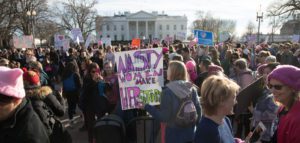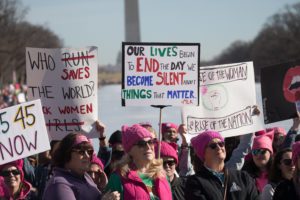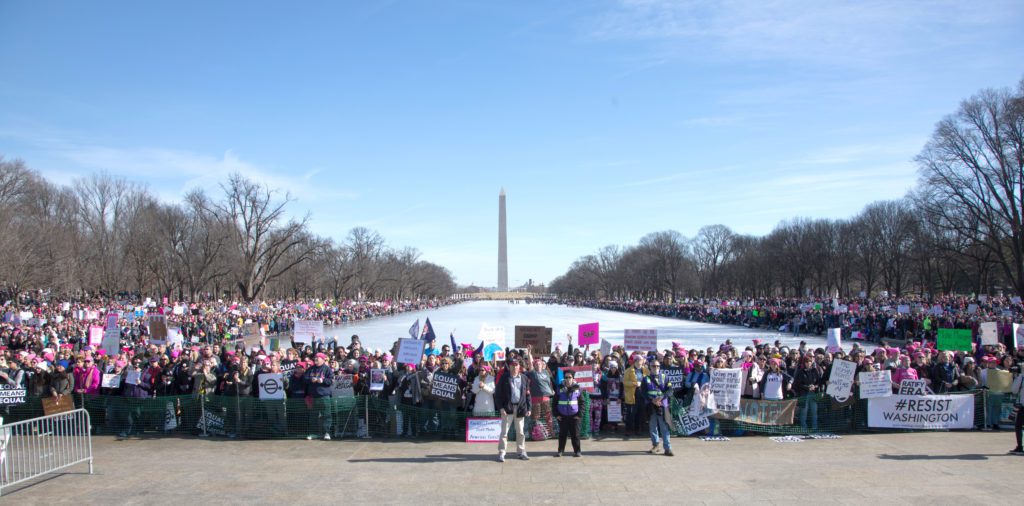Thousands of activists brandishing signs and sporting signature pink “pussycats” gathered on the National Mall and marched to the White House on Saturday, Jan. 20. Participating in the 2018 Women’s March on Washington, D.C., the marchers were demanding respect for woes and protesting against President Donald Trump and his policies. It was one of several such protests around the world marking the anniversary of President Trump’s first year in office.
According to the event’s organizers, a key aim was to encourage women to engage in the political process, including running for office. Sen. Tim Kaine (D-Virginia) and House Minority Leader Nancy Pelosi (D-California) were the principal speakers. The second such protest since Donald Trump entered the White House, the march promises to be an annual event.
Photos by Jeff Malet




House Minority Leader Nancy Pelosi.

Batala Washington is an all-women Afro-Brazilian band that plays samba-reggae rhythms.

Thousands of activists gathered on the National Mall and marched to the White House for the 2018 Women’s March on Washington D.C. on Jan. 20, demanding respect for women and protesting against President Donald Trump and his policies – one of several such protests around the country marking the anniversary of President Trump’s first year in office.

This one-year-old has had enough.

The sign quotes Martin Luther King Jr.: “Our lives begin to end the day we become silent about things that matter.”

The sign reads “Nolite te bastardes carborundorum” – a phrase found in Margaret Atwood’s novel “The Handmaid’s Tale” which means “Don’t let the bastards grind you down” in grammatically incorrect Latin.
For Congress, It’s Not Just Women — It’s People Power
By Peggy Sands
There were two significant marches in Washington, D.C., and around the nation last week. They drew thousands of chanting, whooping, women activists for daylong events focused on women’s issues.
The Jan. 19 event was the annual pro-life demonstration at the Capitol. The Jan. 20 march — held on the one-year anniversary of the historic rallies opposing President Donald Trump and his policies, the day after his 2017 inauguration — was about women expanding their political voice and influence.
What significance might these energizing marches have in 2018?
One of the main goals, of course, is to influence the midterm congressional elections on Nov. 6. The stakes are high. There is always a chance in midterm elections to change the majority in the Senate and/or the House, which controls the legislative agenda.
This year, Democrats will have to win 23 Republican-held seats and hold all of their 194 to flip the majority. Already, a record number of Republican representatives in Congress have announced that they are not running. In the Senate, although Republicans have only a two-seat majority, the Democrats must defend 25 of the 33 seats up for election.
Democratic analysts think that, because the majority often loses seats in midterm elections, and given President Trump’s historically low approval rating, especially among women, Democrats could have a wave to ride. A flipped Democratic Congress could take up the impeachment of President Trump. Most believe, however, that the Senate will remain Republican.
Everything will depend on voter turnout. And that increasingly depends not just on party affiliation, but on how much voters like — or are even excited about — the candidates and the issues they stand for.
“They marched. Now there are more women running for office than ever before,” declared the headline of the Jan. 29 issue of Time magazine. Most of the women considering running for office in 2018 and featured by the press are Democrats. Many are members of minority groups. Most are running on an anti-everything-Trump platform.
But there are Republican women as well. In Virginia, Republican Barbara Comstock is likely to keep her seat. In Maryland, former Deputy Undersecretary of the Army Amie Hober has a good chance to flip the Democratic seat of retiring Rep. John Delaney.
How the midterm election goes for women and their parties could indicate how the 2020 presidential election will go. But 2020 is highly important for another reason: every 10 years, the U.S. Census finalizes the population count for the past decade. On the basis of that, congressional districts are configured by each state government. Whichever party controls the state legislatures can determine the electoral districts and influence which party wins elections for the next decade.


